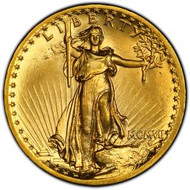The Real Model for Saint-Gaudens' Liberty
Posted by Bullion Shark on Nov 5th 2021
The Real Model for Saint-Gaudens' Liberty

In 2017 to mark the 225th anniversary of the founding of the United States Mint in 1792, a $100 gold Liberty coin struck in high relief (that was also issued in 2018 in a 1/10th-ounce size) was issued. It was also issued later in a series of silver medals.
That gold coin, whose obverse features a left-facing profile of a young African-American woman wearing the crown of stars worn by the famous emancipation statue of a freed black slave that rests at the top of the U.S. Capitol building, was often described as the first American gold coin to feature a black female Liberty on it, including in extensive press coverage of this piece in the mainstream media.
But based on research that surfaced in 1991 from one of her relatives (which was published that year in Numismatic News) and subsequent work that also confirms this information, it now appears very likely, if not certain, that the woman who served as the model for Liberty on the obverse of Augustus Saint-Gaudens legendary $20 gold coin was Hettie E. Anderson, a black American woman with fair complexion.
Prior to the surfacing of that work, most numismatists had long assumed the model for Saint-Gaudens’ Liberty figure had been most likely a woman named Mary Cunningham, an Irish-American waitress in New Hampshire who had served the sculptor at a restaurant, or perhaps his Swedish mistress Davida clark, or Alice Butler of Vermont.
Saint-Gaudens’ son, Homer, who edited and published his father’s memoirs after the artist’s passing, had worked to remove any references to either Clark of Anderson doing any modelling for his father. In addition, Anderson herself contributed to her lack of credit as the model by refusing to allow the Saint-Gaudens family permission to make a copy of a bust of the goddess Victory that the artist had based on her features after modelling for him. She apparently did this because she knew there was only one original of this bust and that if she were to allow it to be copied, it would depreciate in value.
The Victory bust was part of Saint-Gaudens extensive work on one of his most important monumental sculptures in honor of Civil War General William Tecumseh Sherman for the Grand Army Plaza at the entrance of New York’s Central Park which was unveiled on Memorial Day 1903.
Saint-Gaudens had spent most of the prior decade working (and re-working because he was such a perfectionist) on this amazing set of sculptures that includes a winged Victory of which he was especially proud and which based or at least deeply inspired by Anderson.
Anderson, who was born in South Carolina, in 1873, and who also went by Hattie, in 1895 was living in Manhattan supporting herself as a clerk and model for a number of prominent sculptors, including Saint-Gaudens, Adolph Weinman, Bela Lyon Pratt and many others.
The Victory statue also served as a major inspiration for the $20 gold Double Eagle that was created through an extensive partnership between President Theodore Roosevelt and Saint-Gaudens that is widely known as “the pet crime”, which is a reference to the complete redesign of out coinage that occurred through this partnership and the work of many other sculptors in the early 20th century.
When President Roosevelt and Saint-Gaudens exchanged extensive correspondence in 1905 about the $20 gold Liberty project, they agreed that Liberty should be portrayed in a lifelike manner striding forward towards the dawn of new day.
Roosevelt asked the artist about depicting Liberty as a Native American figure, perhaps wearing a feathered headdress. The artist responded that making her appear as a Native American might go against the intent of the legislation that created the coin but that he was in agreement about the headdress.
In fact, early sketches he prepared of Liberty showed her with wings and a headdress and carrying a shield, as shown in this 5-ounce silver medal that features that early design that never appeared on a coin.
But later they decided to use the headdress only for the obverse of the $10 gold Liberty, which features a profile with that motif, which is why that coin is known as an Indian $10 gold coin today.
As for the Liberty for the $20 coin, Saint-Gaudens found it challenging to integrate the wings and spent some time developing a different Liberty figure that instead shows her holding a torch of her right hand and olive branches in her left hand, wearing a flowing gown. Her profile on the final version is believed to be inspired by the Victory statue and the modelling that Henrietta Anderson did for him for that project.
The $10 and $20 gold Liberty coins that Saint-Gaudens designed before his death in 1907, which he never saw in hand, are widely considered America’s crowning numismatic achievements and the great legacy of the coinage renaissance of this period.
And that also helps explain why the obverse of the $20 Liberty gold coin continues to appear on American Gold Eagles issued since 1986. And the Ultra High Relief version of the 1907 $20 gold coin that proved impractical to mint in large quantities because of the relief and the number of times it had to be struck to look that way was later reissued in 2009 using modern minting technology that enabled the 21st century Mint to achieve what the Mint could not in 1907.


